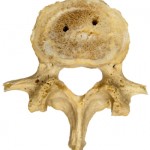I have a family history of back problems as well as a personal one. I don't know exactly what my Aunt Millie's (Dad's sister) back issue was, but it bothered her for many years; otherwise she seemed completely healthy until she died abruptly of cardiac disease at age ninety. My Dad never had back surgery, but often had back problems. Those may have been muscular, as his golf game seemed to be connected to his pain. He'd say, "I shouldn't have used that three-iron; it twisted up my back."
The website of the NIH's National Institute of Neurological Disorders and Stroke has a ten-page Low Back Pain Fact Sheet with the comment that Americans' LBP is our most common job-related disability and, as a neurological affliction, trails only headache in frequency. Much of it resembles Dad's three-iron comment; it's often exercise or work-associated and lasts just a few days.
But some is chronic and overall the amount of money spent on LBP is staggering, $50 billion a year.
My wife has also had low back pain (LBP) problems and wrote a story for one of the Chicken Soup books with her title being, "How Pilates Saved me from Surgery." That concerned her first episode of severe LBP eight years ago when an MRI showed disc disease in her lumbar area (below the ribs and above the sacrum). At that time she saw the same Denver neurosurgeon who has operated on me and he said, "It's too soon for surgery. I'll arrange for an injection by an anesthesiologist in Fort Collins (I played the D card, calling for her and saying this is Doctor Springberg, and she got her shot the very next day).
She mentioned Pilates to the neurosurgeon and he approved her going to a class with some caveats. She told her instructor about her back problem and the health club's experienced teacher said, "That's no problem; there are some exercises I'll modify for you and some you should not do at all."
I had seen the online story of a woman who hadn't had the same positive experience; she and others have cautioned that Pilates is not the answer for everyone, unless you have an instructor familiar with the limitations necessary for some students.
Lynnette has remained slender and exercised five or six days a week (Pilates on three days and a class called "Strong women, Strong Bones " twice a week + stretches every day and one or two trips to the gym with me). Then she had a flareup over the last few months. She saw our favorite physical therapist, got new exercise and posture ideas and is back to low-grade soreness (two on a pain scale of one to ten). There's no surgery in sight.
She also has a strong family history of chronic LBP; her mother had it for years and her sister has had two operations thus far and numerous injections of either steroids or pain medication.
My first episode of acute LBP happened forty-four years ago when I was a clinical Nephrology fellow at Duke, was relatively inactive and had gained lots of weight (I was at 216 pounds and had wrestled at 155 in college). The NIH Fact Sheet says most acute LBP is mechanical in nature, happens most commonly to those aged 30 to 50 who have a sedentary lifestyle and may be overweight.
I certainly fit that picture back in 1969 except I was only 28; today I weighed 149.4 pounds.
Chronic LBP, defined as pain that persists for at least three months, is another matter. It has lots of causes, especially disk disease. That statement requires considerable background. Your spinal cord is a major part of the nervous system with literally millions of nerve fibers that transmit information to and from the brain and the arms, legs, organs, and trunk of your body. It's fairly delicate so to protect it you have a series of barriers and cushions starting with the spinal column (AKA the spine), a series of bones called vertebrae. There are seven in the neck region (the cervical vertebrae) twelve in your upper back (thoracic area technically), five in the lumbar (low back) area, and then a set that are fused together (your sacrum and coccyx, AKA tail bone), making up a rough and slightly variable total of thirty.
Each one of the vertebrae has a body, the main area for weight bearing, and an off-round hole that the spinal cord passes through. Branches of the cord, AKA nerve roots, pass through other spaces in each vertebra; these are called foramina (the term comes from Latin and means a natural opening). The bony structures are separated by intervertebral discs , rubbery pads held in place by muscles and ligaments. The posterior part of the vertebrae has a portion termed the spinous process. That's what you can feel when you touch somebody's back and move your hands up and down.. It also has wing-like bony structures (transverse processes) on each side where back muscles attach. A particular vertebra is connected to the next vertebra up and downstream by facet joints, stabilizing links which allow twisting motions especially in the neck and low back (very limited in the chest area).
The spinal cord itself is cushioned by a fluid called the cerebrospinal fluid or CSF. It is produced in the skull and serves multiple purposes for the brain: buoyancy, allowing the brain to be densely packed without cutting off its own blood supply; protection from being jolted or hit; chemical stability by removing metabolic waste and allowing distribution of neuroendocrine chemicals (e.g., the nine hormones from the pituitary gland).
One more bit, then I'll quit this prolonged anatomy lesson; The spinal cord ends higher in the back than the spinal column. At the bottom of the cord is a bundle of nerve roots that send messages to and from the legs and pelvic organs. These are called the cauda equina (Latin for horse's tail). Rarely they can get compressed by a ruptured disc, tumor, infection, car crash, a significant fall, gunshot or knife wound, fracture, or narrowing of the spinal canal.
When that happens, it's a surgical emergency, called the cauda equina syndrome.
So your spine is a highly articulated, complex structure and lots can go wrong with it.
More on that in my next post.
Tags: cauda equina syndrome, CSF, disc disease, facet narrowing, low back pain, spinal column, spinal cord, spinal stenosis, vertebrae



At the impending arrival of a newborn many new parents are pre-occupied with items to purchase and how exactly to decorate the
baby's room. Regretfully, this means that many parents might not be advised on cord blood donation and the value of doing so. If only more parents could donate their baby umbilical stem cells it could help to cure more diseases (right now it helps to cure about eighty conditions and illnesses) and save more peoples lives.